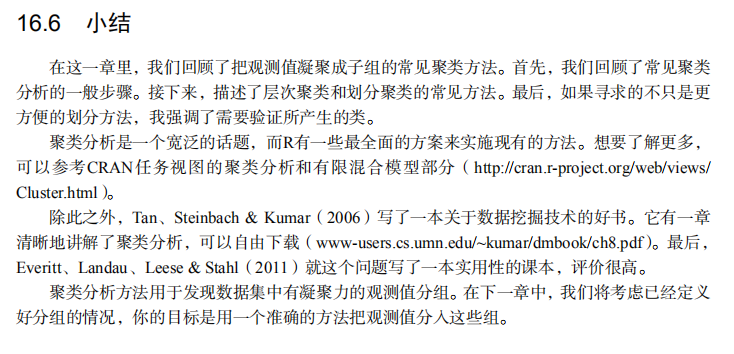吴裕雄--天生自然 R语言开发学习:聚类分析(续一)























#-------------------------------------------------------#
# R in Action (2nd ed): Chapter 16 #
# Cluster analysis #
# requires packaged NbClust, flexclust, rattle #
# install.packages(c("NbClust", "flexclust", "rattle")) #
#-------------------------------------------------------# par(ask=TRUE)
opar <- par(no.readonly=FALSE) # Calculating Distances
data(nutrient, package="flexclust")
head(nutrient, 2)
d <- dist(nutrient)
as.matrix(d)[1:4,1:4] # Listing 16.1 - Average linkage clustering of nutrient data
data(nutrient, package="flexclust")
row.names(nutrient) <- tolower(row.names(nutrient))
nutrient.scaled <- scale(nutrient)
d <- dist(nutrient.scaled)
fit.average <- hclust(d, method="average")
plot(fit.average, hang=-1, cex=.8, main="Average Linkage Clustering") # Listing 16.2 - Selecting the number of clusters
library(NbClust)
nc <- NbClust(nutrient.scaled, distance="euclidean",
min.nc=2, max.nc=15, method="average")
par(opar)
table(nc$Best.n[1,])
barplot(table(nc$Best.n[1,]),
xlab="Numer of Clusters", ylab="Number of Criteria",
main="Number of Clusters Chosen by 26 Criteria") # Listing 16.3 - Obtaining the final cluster solution
clusters <- cutree(fit.average, k=5)
table(clusters)
aggregate(nutrient, by=list(cluster=clusters), median)
aggregate(as.data.frame(nutrient.scaled), by=list(cluster=clusters),
median)
plot(fit.average, hang=-1, cex=.8,
main="Average Linkage Clustering\n5 Cluster Solution")
rect.hclust(fit.average, k=5) # Plot function for within groups sum of squares by number of clusters
wssplot <- function(data, nc=15, seed=1234){
wss <- (nrow(data)-1)*sum(apply(data,2,var))
for (i in 2:nc){
set.seed(seed)
wss[i] <- sum(kmeans(data, centers=i)$withinss)}
plot(1:nc, wss, type="b", xlab="Number of Clusters",
ylab="Within groups sum of squares")} # Listing 16.4 - K-means clustering of wine data
data(wine, package="rattle")
head(wine)
df <- scale(wine[-1])
wssplot(df)
library(NbClust)
set.seed(1234)
nc <- NbClust(df, min.nc=2, max.nc=15, method="kmeans")
par(opar)
table(nc$Best.n[1,])
barplot(table(nc$Best.n[1,]),
xlab="Numer of Clusters", ylab="Number of Criteria",
main="Number of Clusters Chosen by 26 Criteria")
set.seed(1234)
fit.km <- kmeans(df, 3, nstart=25)
fit.km$size
fit.km$centers
aggregate(wine[-1], by=list(cluster=fit.km$cluster), mean) # evaluate clustering
ct.km <- table(wine$Type, fit.km$cluster)
ct.km
library(flexclust)
randIndex(ct.km) # Listing 16.5 - Partitioning around mediods for the wine data
library(cluster)
set.seed(1234)
fit.pam <- pam(wine[-1], k=3, stand=TRUE)
fit.pam$medoids
clusplot(fit.pam, main="Bivariate Cluster Plot") # evaluate clustering
ct.pam <- table(wine$Type, fit.pam$clustering)
ct.pam
randIndex(ct.pam) ## Avoiding non-existent clusters
library(fMultivar)
set.seed(1234)
df <- rnorm2d(1000, rho=.5)
df <- as.data.frame(df)
plot(df, main="Bivariate Normal Distribution with rho=0.5") wssplot(df)
library(NbClust)
nc <- NbClust(df, min.nc=2, max.nc=15, method="kmeans")
par(opar)
barplot(table(nc$Best.n[1,]),
xlab="Numer of Clusters", ylab="Number of Criteria",
main ="Number of Clusters Chosen by 26 Criteria") library(ggplot2)
library(cluster)
fit <- pam(df, k=2)
df$clustering <- factor(fit$clustering)
ggplot(data=df, aes(x=V1, y=V2, color=clustering, shape=clustering)) +
geom_point() + ggtitle("Clustering of Bivariate Normal Data") plot(nc$All.index[,4], type="o", ylab="CCC",
xlab="Number of clusters", col="blue")
吴裕雄--天生自然 R语言开发学习:聚类分析(续一)的更多相关文章
- 吴裕雄--天生自然 R语言开发学习:R语言的安装与配置
下载R语言和开发工具RStudio安装包 先安装R
- 吴裕雄--天生自然 R语言开发学习:数据集和数据结构
数据集的概念 数据集通常是由数据构成的一个矩形数组,行表示观测,列表示变量.表2-1提供了一个假想的病例数据集. 不同的行业对于数据集的行和列叫法不同.统计学家称它们为观测(observation)和 ...
- 吴裕雄--天生自然 R语言开发学习:导入数据
2.3.6 导入 SPSS 数据 IBM SPSS数据集可以通过foreign包中的函数read.spss()导入到R中,也可以使用Hmisc 包中的spss.get()函数.函数spss.get() ...
- 吴裕雄--天生自然 R语言开发学习:使用键盘、带分隔符的文本文件输入数据
R可从键盘.文本文件.Microsoft Excel和Access.流行的统计软件.特殊格 式的文件.多种关系型数据库管理系统.专业数据库.网站和在线服务中导入数据. 使用键盘了.有两种常见的方式:用 ...
- 吴裕雄--天生自然 R语言开发学习:R语言的简单介绍和使用
假设我们正在研究生理发育问 题,并收集了10名婴儿在出生后一年内的月龄和体重数据(见表1-).我们感兴趣的是体重的分 布及体重和月龄的关系. 可以使用函数c()以向量的形式输入月龄和体重数据,此函 数 ...
- 吴裕雄--天生自然 R语言开发学习:基础知识
1.基础数据结构 1.1 向量 # 创建向量a a <- c(1,2,3) print(a) 1.2 矩阵 #创建矩阵 mymat <- matrix(c(1:10), nrow=2, n ...
- 吴裕雄--天生自然 R语言开发学习:图形初阶(续二)
# ----------------------------------------------------# # R in Action (2nd ed): Chapter 3 # # Gettin ...
- 吴裕雄--天生自然 R语言开发学习:图形初阶(续一)
# ----------------------------------------------------# # R in Action (2nd ed): Chapter 3 # # Gettin ...
- 吴裕雄--天生自然 R语言开发学习:图形初阶
# ----------------------------------------------------# # R in Action (2nd ed): Chapter 3 # # Gettin ...
- 吴裕雄--天生自然 R语言开发学习:基本图形(续二)
#---------------------------------------------------------------# # R in Action (2nd ed): Chapter 6 ...
随机推荐
- Mybatis 使用分页查询亿级数据 性能问题 DB使用ORACLE
一般用到了mybatis框架分页就不用自己写了 直接用RowBounds对象就可以实现,但这个性能确实很低 今天我用到10w级得数据分页查询,到后面几页就迭代了很慢 用于记录 1.10万级数据如下 [ ...
- drf序列化单改-整改-局部改-群改接口的实现
整体单改 路由层.模型层.序列化层不需要做修改,只需要处理视图层:views.py """ 1) 单整体改,说明前台要提供修改的数据,那么数据就需要校验,校验的数据应该在 ...
- SRS|Stratified sampling|系统抽样|Cluster sampling|multistage sampling|
生物统计学 总体和抽样 抽样方法: ========================================================= 简单随机抽样SRS:随机误差,系统误差 标准误, ...
- 第二季第十一天 html5语义化标签 css透明度
span不能设置宽高背景 HTML5语义化标签 <section>标签所包裹的是有一组相似的主题的内容,可以用这个标签来实现文章的章节.标签式对话框中的各种标签页等类似的功能. <s ...
- Linux-守护进程的引入
1.进程查看命令ps (1).ps -ajx 偏向显示各种有关的ID号 (2).ps -aux 偏向显示进程各种占用资源 2.向进程发送信号指令kill (1).kill -信号编号 进程ID,向一 ...
- E - Ingredients 拓扑排序+01背包
题源:https://codeforces.com/gym/101635/attachments 题意: n行,每行给定字符串s1,s2,s3代表一些菜谱名.s2和s3是煮成是的必要条件,然后给出c和 ...
- vue slot插槽v-show不控制显示隐藏
vue中想控制插槽的显示隐藏,用v-show是不起任何作用的,改用v-if 可以生效.
- TPO3-1Architecture
Much of the world's great architecture has been constructed of stone because of its beauty, permanen ...
- bat脚本修改dns(判断系统版本)
@echo off systeminfo if "%OS 名称%"=="%7%" goto windows7:windows7echo 正在设置本机主DNS , ...
- 三十五、lamp经典组合搭建
一.安装mysql数据库 1.1 创建组和用户: 1)groupadd mysql 2)useradd mysql -g mysql -M -s /sbin/nologin 3)config ...
